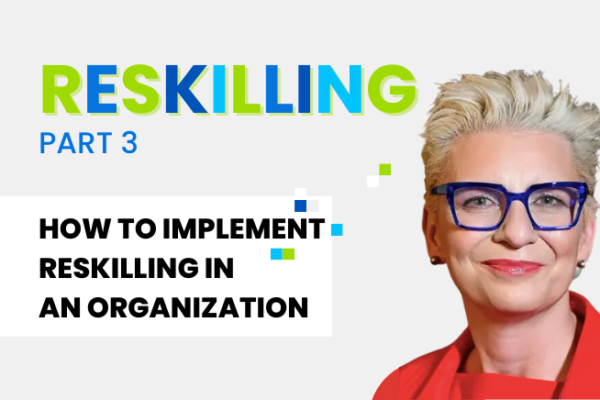WATCH WEBINAR (PL): Reskilling - how to plan and implement a strategy to engage and effectively reskill employees
The artificial intelligence revolution is ongoing, and we need to realize the magnitude of the changes it has on our reality. In particular, digital technologies have significantly accelerated during the pandemic, leading to the transformation of many companies. Companies that previously only had IT teams responsible for back-office operations have now become dynamic technology enterprises. However, these technologies not only change the way companies operate but also shape the expectations of customers and employees.
The pace of these changes and how the world is evolving, not just in terms of new technologies, is perfectly illustrated by the numbers: it took 75 years to reach 100 million users of landline telephony. Mobile phones reached 100 million users in 16 years. The Internet reached 100 million users in just 7 years. TikTok reached that number of users in 9 months, which until recently seemed like an absolute record. However, that record was surpassed by ChatGPT, which reached 100 million users in 8 weeks!
These data not only show the introduction of new technologies into the market but also the incredibly rapid scaling and acceleration of these solutions. This greatly changes our reality. In the Polish market, in addition to having some of the best programmers and developers, companies such as Intel and, of course, OpenAI, which plans to build a team of competent experts in Poland, are also starting to invest. As an example, I will mention a discussion at the University of Warsaw, during which Sam Altman, CEO of OpenAI, asked, "How is it possible that Poland has so many great engineers and talented people in areas such as research, data analysis, and new technologies?" This clearly shows that, alongside this scaling and acceleration, our companies must develop technological skills and competencies. That is why it is so important to talk about reskilling, emphasizes Tina Sobocińska.
So, how do we start reskilling?
The key is understanding the need for reskilling and answering the question "why". It is important to consider the company's strategy and the demand for new competencies. Collaboration between the HR department and the business is crucial here. Discussions about organizational goals, development direction, and required skills should take place at various levels to proactively address the issue of reskilling.
One example of the need for reskilling may be technological changes. The introduction of new technological solutions, such as voice bots and chatbots in customer service centers, may raise questions about the future of employees working in this field. Traditional methods, such as outplacement, may be considered, but it is also worth thinking about reskilling these employees. This provides an opportunity to retain loyal and experienced employees who know the customers, the company's offerings, and its structure. However, reskilling requires the engagement of the entire organization and time for proper preparation. Therefore, it is worth organizing the first workshop to define goals in advance and consider how these changes affect employees, suggests Tina Sobocińska.
Transparency within the organization is another essential aspect. Employees are increasingly aware of technological changes and their impact on their work. Therefore, it is valuable to communicate clearly what technologies are being introduced in the company and what consequences they will have for employees.
Initiating reskilling also requires setting strategic goals and planning actions. Technological changes and the need for relevant skills should be incorporated into the organization's strategy. Preparing a business case that evaluates the costs and benefits of reskilling is also important to convince management to invest in employee development.
One of the first steps in reskilling can be conducting a pilot program. More and more organizations are choosing to test the reskilling process on a selected group of employees, especially those whose work can be automated. The results of such pilots are promising, and companies often decide to expand the reskilling program on a larger scale.
Demographic changes are another factor that motivates companies to invest in reskilling. An aging society requires organizations to be flexible and capable of retraining internal employees. This not only fulfills social responsibility but also allows organizations to retain valuable employees in entirely new roles, bringing long-term benefits.
It is essential to pay attention to the stakeholders involved in reskilling, which includes various groups. Board engagement is crucial because in organizations where the board is involved, reskilling becomes a strategic initiative. Moreover, reskilling often triggers other changes, such as a shift in organizational culture. This refers to an organization that is dynamic, open to learning, and invests in the learning process. It involves not just investing in specific programs, certifications, or courses, but also determining the proportion of time dedicated to learning. The number of stakeholders may vary depending on the organization and the complexity and scale of the reskilling program, whether it is a pilot project or a large-scale reskilling initiative. All of this requires proper preparation. Collaboration with employee representatives or trade unions is also crucial, depending on the situation in the organization and the goals of reskilling. This aims to ensure a transparent process that presents the organization positively and in line with its intentions. It is essential to avoid later obstacles arising from a lack of understanding and acceptance of the intentions and goals of reskilling by certain groups within the organization. Therefore, building a communication plan is necessary to achieve understanding and acceptance for reskilling.
Furthermore, developing an operational plan and process is essential, which involves defining the stages that will guide us through reskilling. This includes determining who will be involved in the process, how to align specific stages with the communication plan, what we want to achieve, and whom we want to convey the information to. In the case of reskilling, which often involves medium- to long-term initiatives, a roadmap tailored to the organization and the scale of the reskilling program is built. It could be a roadmap for one year, two years, or three years. The roadmap serves as the starting point and allows for the development of a detailed communication plan. Objectives and success indicators are established, at least for the initial stages, to assess whether progress is on track and to make necessary adjustments to actions or the project team as needed. The project team, which is often multidisciplinary, plays a crucial role. It's worth noting that while HR often initiates reskilling-related topics and acts as a coordinator in the reskilling program, the project team consists of representatives from various areas of the organization, depending on the scope of the reskilling.
It is crucial to include both present and future teams in the project team, those who release employees for reskilling and those who will receive the retrained employees. Defining appropriate roles and tasks is necessary for effectively implementing reskilling. Regular progress checks are also important to evaluate whether assumptions are practical and whether further adjustments are necessary to continue reskilling with the best results. Remember that reskilling is a dynamic process that requires continuous improvement and adaptation to changing conditions.
Mentoring in the HR area is another essential element, particularly for organizations that lack prior reskilling experience and need support. A strategic approach to reskilling often arises from the need of companies facing challenges in acquiring new talents to carry out their projects. The current job market is changing, and companies may encounter difficulties in finding candidates with the right skills. This is where reskilling can be an excellent solution. Therefore, it is essential to observe market trends and, while planning reskilling actions, develop a detailed operational plan. Effective reskilling requires appropriate tools, often necessitating collaboration with external partners, such as Future Collars, who have course and training platforms as well as experienced mentors. External partners can help with the operational implementation of reskilling in our organization. It is crucial to carefully select external partners through tenders, discussions, and checking recommendations. Testing or evaluating their skills through agreements and SLAs should also be done. At the same time, a risk analysis should be conducted, and a risk management plan should be developed.
HR Policies in Reskilling
In the market, various proven solutions related to reskilling can be found. One such approach is a company investing in training courses while employees invest their time. Often, this time is spent after working hours or during weekends, which employees dedicate to developing new competencies. Many employees understand and accept this approach.
Another example is a solution where the company expects minimal financial involvement from the employee. This policy aims to increase the employee's motivation to complete the course. The psychological mechanism makes even minimal financial commitment a driving force to complete the training.
Employer Dilemmas | Concerns and Risks
One of the frequent risks associated with reskilling is the fear that employees being invested in for upskilling may not complete the courses they have started. This is one of the most common concerns cited by HR personnel or organizational leaders. Therefore, it is important to have external support and experience or utilize a methodology based on external experience to assist employees going through the reskilling process.
Another risk often mentioned by companies concerned about reskilling is how to retain employees who have gone through this process. There are many experiences and approaches to this issue. One example is building an internal recruitment culture in which the employee is the author of their development. This approach allows aligning the employee's motivation, competencies, and predispositions with the new role they aspire to. Employees can actively participate in internal recruitment or arrange a conversation with the leader of the new team they are interested in.
Many companies question whether it is worthwhile to sign training agreements with employees when investing in their development. In this context, it is worth considering various solutions and the consequences of decisions. There are examples of companies that do not opt for such agreements. There have been situations where employees declined to sign training agreements despite investments in their development. This posed a serious dilemma concerning maintaining such a policy. It is worth considering the consequences of investing in employees as part of corporate social responsibility (ESG). Although not all employees participating in reskilling will find a place in the organization, those who leave will be better prepared for future challenges in the job market. They may become our clients or ambassadors, so this aspect should be considered in the strategy.
Additionally, providing clear career paths and compensation structures for experts in areas where new employees with new competencies join the team after reskilling is essential. We must have organized job titles, hierarchy, compensation, and other elements influencing employee retention and talent strategies. All employees should have the opportunity for development in various roles, regardless of their level of competence.
Success Factors from the Employee's Perspective
To ensure the success of reskilling at an advanced stage, when we are already participating in a course or program and gaining new competencies for a new role, team support is crucial. The team that accepts, assists, integrates with us, and conducts proper onboarding in the company.
Of course, individuals participating in reskilling can also benefit from internal mentors. Another important aspect is having ambassadors, individuals in various roles who believe in the possibility of upskilling and support others through their example. Communication can be built based on their authentic and convincing stories (her/his story). We can also share lessons learned from the reskilling process, not only in terms of acquiring competencies but also what helped us go through this process.
It is important for employees to have practical support, not only at work but also in their private lives. They exchange experiences regarding managing personal time, childcare, and leisure time while intensely engaged in reskilling.
Furthermore, the educational platform must be tailored to the needs and experiences of reskilling participants. It should be user-friendly and offer engaging solutions conducive to adult learning. Choosing the right partner or solution is crucial in this regard.
HR as a Strategic Business Partner
Reskilling positions HR as a strategic business partner. It is an action with many benefits for the organization, employees, and the company's image in the short and long term.
Read more:
Part 1 - The Strategic Role of Reskilling
Part 2 - Reskilling from the Employee's Perspective
***
This article is based on the webinar "Competence Development and Reskilling - Key to Success in a Dynamic Business World" organized by Future Collars. The webinar featured experts: Tina Sobocińska, Joanna Pruszyńska-Witkowska, and Adrian Siemieniak.
***
Tina Sobocińska - an experienced HR leader with over 20 years of experience both in large corporations and as an advisor. For the past 2 years, she has focused on reskilling and upskilling trends. Her expertise includes advising on hybrid work implementation, defining future competencies, and collaborating with Future Collars on reskilling initiatives. Tina is also a respected lecturer at SWPS postgraduate studies and teaches at SGH and the Leon Koźmiński Academy. She engages in recording podcasts and conducting interviews with leaders to prepare companies for challenging times.
Joanna Pruszyńska-Witkowska - Co-founder of Future Collars - a digital competence school. She has over 20 years of experience in running public relations agencies. Always interested in empowering women, the idea of helping women prepare for technological changes and providing them with new opportunities in the IT sector was born. This vision led to the creation of Future Collars, which currently has 60% to 67% female graduates, examples of completely changing their careers and entering the IT world, regardless of age, previous experience, or education.
Adrian Siemieniak - Business Development Manager at Future Collars. He advises companies that want to thrive in the world of new technologies by equipping their employees with essential digital competencies.
***
Future Collars is a leading digital competence school specializing in reskilling and upskilling employees. The school offers online courses in programming and software testing, providing practical skills and job placement support.
More information about Future Collars' offerings can be found on their website: https://futurecollars.com/en










